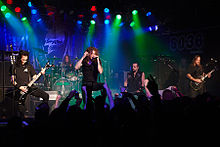SO36


The SO36 club is a music club on Oranienstrasse near Heinrichplatz in the area of Kreuzberg in Berlin, Germany.
It takes its name from the historic postcode of that area, SO36, in which the SO stands for Südost (South East). The Kreuzberg district has historically been home to the Berlin punk rock movement, as well as other alternative subcultures in Germany.
History
SO36 was originally focused largely on punk music and in the 1970s was often frequented by musicians such as Iggy Pop and David Bowie. After problems Martin Kippenberger took over the management in 1979 and tried to create a crossover between punk, new wave and visual art.[1] In those days the club rivaled New York's CBGB as one of the finest new-wave venues in the world.[citation needed] However unlike CBGB the venue still stands as of November 2015 and remains a fixture on the Berlin music scene championing new artists, while staying true to its punk past.[citation needed]
Notable cultural connections
English rock band Killing Joke named a song $,O,36 on their eponymous first album, but it is unclear if the song was based on the postal code or the club.[citation needed] The Electric Ballroom held at the club is considered a legendary fixture of the Berlin Techno gay scene.[2] Gayhane founded 1997 by Turkish performer Fatma Souad is the nucleus of the Berlin Turkish gay and lesbian community.[3] DJ Ipek, an internationally known DJ and performer at the club, is responsible for the Gayhane mixture of Arabic, Turkish and Indian music. German photographer Nicolaus Schmidt created both a documentary and fictitious portrait of the club, called an "amalgam of western and oriental culture".[4]
References
- ^ Frank Apunkt Schneider: Als die Welt noch unterging – Von Punk zu NDW, p 73 f., 2007
- ^ http://www.60by80.com/berlin/gay-clubs/so36.html
- ^ Prof Kira Kosnick, Beyond the Community – Queer Migrant Club Cultures in Metropolitan Spaces, Institute for Cultural Anthropology and European Ethnology, Sussex UK, 2005
- ^ Peter Schwanewilms, exhibition document, Deutsches Haus at NYU - see: calendar spring 2008 detail, April 12, 2008
